
Here you can study for the exam. Look up keywords and learn definitions about all kind of subjects.
More subjects
Dhol (Hindi pronunciation: [ɖʰoːl]) can refer to any one of a number of similar types of double-headed drum widely used, with regional variations, throughout the Indian subcontinent. Its range of distribution in Indian subcontinent primarily includes northern areas such as the Jammu, Himachal, Punjab, Haryana, Delhi, Kashmir, Sindh, Assam Valley, Uttarakhand, West Bengal, Odisha, Gujarat, Maharashtra, Konkan, Goa, Karnataka, Rajasthan, Bihar, Jharkhand and Uttar Pradesh. A related instrument is the dholak or dholki. Dhols are amongst other events used in Indian wedding ceremony processions such as Baraat or Varyatra. Someone who plays the dhol is known as dholi.
The dholak is a two-headed hand drum, a folk percussion instrument. The instrument is about 45 cm in length and 27 cm in breadth and is widely used in qawwali, kirtan, lavani and bhangra. The drum has two different sized drumheads. The smaller drumhead is made of goat skin for sharp notes while the bigger drumhead is made of buffalo skin for low pitch. The two drumheads allow a combination of bass and treble with rhythmic high and low pitches. The body or shell of the Dholak is made of sheesham or mango wood. The larger membrane has a compound (Syahi) applied which helps to lower the pitch and produce the sound. The smaller drumhead is played with the left hand which produces a high pitch. A cotton rope lacing and screw-turnbuckle are used to release tension while playing. Steel rings/pegs are twisted inside the laces to attain fine tuning. Dholak can be played in three ways — on the player’s lap, while standing, or pressed down with one knee while sitting on the floor.
The didgeridoo (/ˌdɪdʒəriˈduː/; also spelt didjeridu, among other variants) is a wind instrument, played with vibrating lips to produce a continuous drone while using a special breathing technique called circular breathing. The didgeridoo was developed by Aboriginal peoples of northern Australia at least 1,000 years ago, and is now in use around the world, though still most strongly associated with Indigenous Australian music. In the Yolŋu languages of the indigenous people of northeast Arnhem Land the name for the instrument is the yiḏaki, or more recently by some, mandapul. In the Bininj Kunwok language of West Arnhem Land it is known as mako. A didgeridoo is usually cylindrical or conical, and can measure anywhere from 1 to 3 m (3 to 10 ft) long. Most are around 1.2 m (4 ft) long. Generally, the longer the instrument, the lower its pitch or key. Flared instruments play a higher pitch than unflared instruments of the same length.
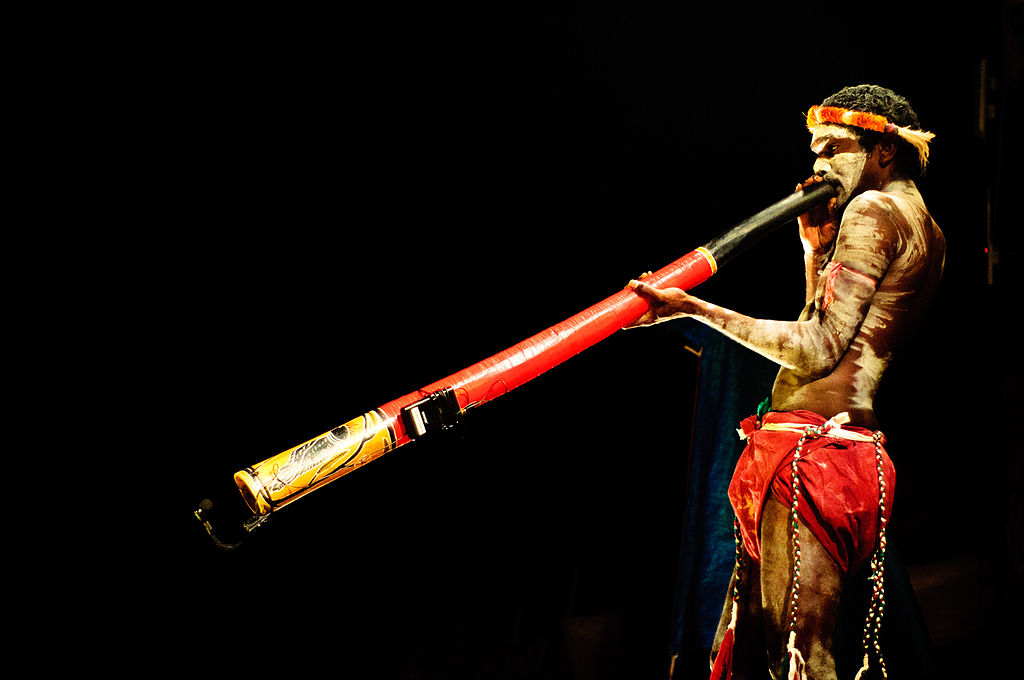 © Wikimedia.org/Graham Crumb, CC BY-SA
© Wikimedia.org/Graham Crumb, CC BY-SA
Diple (pluralia tantum; pronounced [dîple̞], other Croatian names: 'misnjiče', 'miješnice' and 'mih') is a traditional woodwind musical instrument originating in the Adriatic Littoral. It is played in Bosnia and Herzegovina, Croatia, Slovenia, Montenegro, and Serbia The diple may be found as a fipple flute or as a reedpipe, but in either case is distinctive in that it incorporates two bores within one body, and thus creates two notes simultaneously. Generally, the left hand fingers a group of holes on the left side of the body, and the right on its side.
The dizi (Chinese: 笛子; pinyin: dízi, pronounced [tǐt͡sɨ]), is a Chinese transverse flute. It is also sometimes known as the di (笛) or héngdi (橫笛), and has varieties including Qudi (曲笛), Bangdi (梆笛), and Xindi (新笛). It is a major Chinese musical instrument that is widely used in many genres of Chinese folk music, Chinese opera, as well as the modern Chinese orchestra. The dizi is also a popular instrument among the Chinese people as it is simple to make and easy to carry. Most dizi are made of bamboo, which explains why dizi are sometimes known by simple names such as Chinese bamboo flute. However, 'bamboo' is perhaps more of a Chinese instrument classification like 'woodwind' in the West. Northern Chinese dizi are made from purple or violet bamboo, while dizi made in Suzhou and Hangzhou are made from white bamboo. Dizi produced in southern Chinese regions such as Chaozhou are often made of very slender, lightweight, light-colored bamboo and are much quieter in tone.
A djembe or jembe (/ˈdʒɛmbeɪ/ JEM-bay; from Malinke jembe [dʲẽbe], N'Ko: ߖߋ߲߰ߓߋ) is a rope-tuned skin-covered goblet drum played with bare hands, originally from West Africa. According to the Bambara people in Mali, the name of the djembe comes from the saying 'Anke djé, anke bé' which translates to 'everyone gather together in peace' and defines the drum's purpose. In the Bambara language, 'djé' is the verb for 'gather' and 'bé' translates as 'peace.' The djembe has a body (or shell) carved of hardwood and a drumhead made of untreated (not limed) rawhide, most commonly made from goatskin. Excluding rings, djembes have an exterior diameter of 30–38 cm (12–15 in) and a height of 58–63 cm (23–25 in). The majority have a diameter in the 13 to 14 inch range. The weight of a djembe ranges from 5 kg to 13 kg (11–29 lb) and depends on size and shell material. A medium-size djembe carved from one of the traditional woods (including skin, rings, and rope) weighs around 9 kg (20 lb).
The dollu is a double-headed drum native to Karnataka, India[citation needed]. It is classified as a membranophone. The heads are made of sheep or goat skin and the frame is made of honne or mango tree wood. The instrument is used mostly in theatrical dances with religious or mythological themes. It is carried by means of a belt or harness and struck with the hand or a short stick. It is loud, low pitched and not particularly tonal.
The double bass (/ˈdʌbəl beɪs/), also known simply as the bass (/beɪs/), amongst other names, is the largest and lowest-pitched string instrument in the modern symphony orchestra (excluding unorthodox additions such as the octobass). Similar in structure to the cello, it has four, although occasionally five, strings. The bass is a standard member of the orchestra's string section, along with violins, viola, and cello, as well as the concert band, and is featured in concertos, solo, and chamber music in Western classical music. The bass is used in a range of other genres, such as jazz, blues, rock and roll, rockabilly, country music, bluegrass, tango and folk music. The bass is a transposing instrument and is typically notated one octave higher than tuned to avoid excessive ledger lines below the staff. The double bass is the only modern bowed string instrument that is tuned in fourths (like a bass guitar or viol), rather than fifths, with strings usually tuned to E1, A1, D2 and G2.
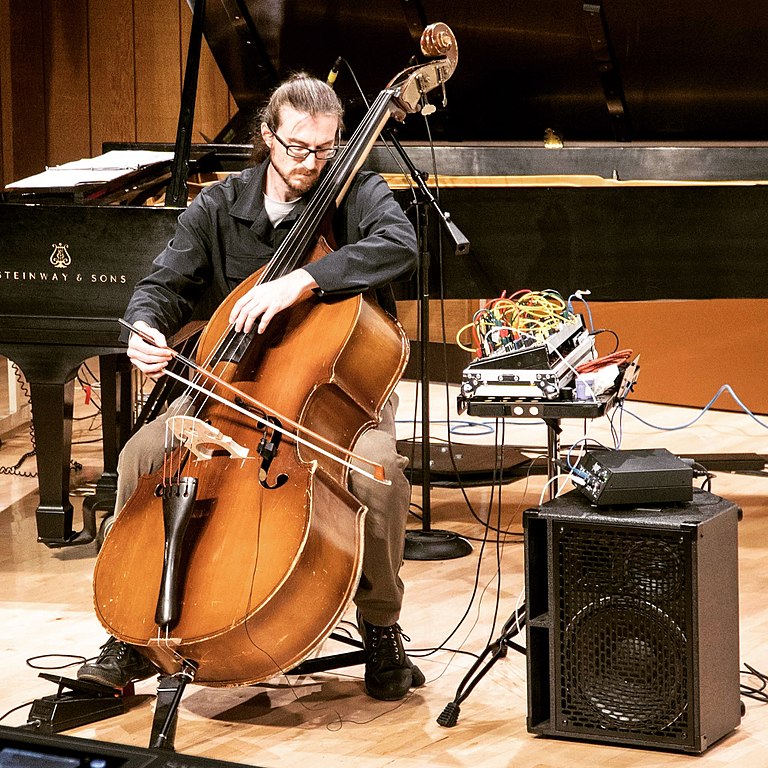 © Wikimedia.org/ Jacob Neuwirth, CC BY-SA
© Wikimedia.org/ Jacob Neuwirth, CC BY-SA
The dreadnought is a type of acoustic guitar body developed by American guitar manufacturer C.F. Martin & Company. The style, since copied by other guitar manufacturers, has become the most common for acoustic guitars. At the time of its creation in 1916 the word dreadnought referred to a large, all big-gun, modern battleship of the type pioneered by HMS Dreadnought in 1906. A body much larger than most other guitars provided the dreadnought with a bolder, perhaps richer, and often louder tone. It is distinguished by its size and square shoulders and bottom. The neck is usually attached to the body at the fourteenth fret. Martin dreadnought guitars are also known as 'D-size' guitars. Their model numbers consist of 'D-' followed by a number, such as 'D-18' and 'D-45'. The higher the numerical designation, the more decorative ornamentation on the instrument.
The drum is a member of the percussion group of musical instruments. In the Hornbostel-Sachs classification system, it is a membranophone. Drums consist of at least one membrane, called a drumhead or drum skin, that is stretched over a shell and struck, either directly with the player's hands, or with a percussion mallet, to produce sound. There is usually a resonant head on the underside of the drum. Other techniques have been used to cause drums to make sound, such as the thumb roll. Drums are the world's oldest and most ubiquitous musical instruments, and the basic design has remained virtually unchanged for thousands of years. Drums may be played individually, with the player using a single drum, and some drums such as the djembe are almost always played in this way. Others are normally played in a set of two or more, all played by the one player, such as bongo drums and timpani. A number of different drums together with cymbals form the basic modern drum kit.
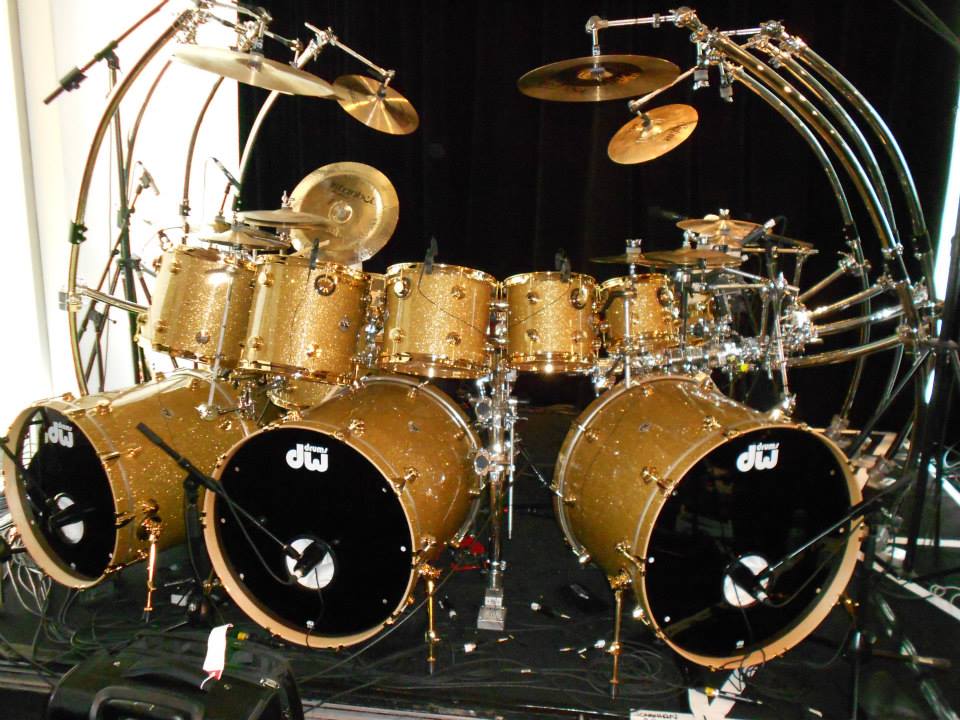 © Wikimedia.org/Mhissami, CC BY-SA
© Wikimedia.org/Mhissami, CC BY-SA
The duduk (/duːˈduːk/ doo-DOOK; Armenian: դուդուկ IPA: [duˈduk]) or tsiranapogh (Armenian: ծիրանափող, meaning “apricot-made wind instrument”), is a double reed woodwind instrument made of apricot wood originating from Armenia. Variations of the Armenian duduk appear throughout the Caucasus and the Middle East, including Azerbaijan, Georgia, Russia, Turkey, and Iran. Duduk, Balaban, and Mey are almost identical, except for historical and geographical differences. It is commonly played in pairs: while the first player plays the melody, the second plays a steady drone called dum, and the sound of the two instruments together creates a richer, more haunting sound. The unflattened reed and cylindrical body produce a sound closer to the English horn than the oboe or bassoon. Unlike other double reed instruments like the oboe or shawm, the duduk has a very large reed proportional to its size.
 © Wikimedia.org, CC0
© Wikimedia.org, CC0
Dunun (Malinké: [ˈdu.nun]; plural dunun) (also spelled dundun or doundoun) is the generic name for a family of West African drums that have developed alongside the djembe in the Mande drum ensemble. A dunun is a rope-tuned cylindrical drum with a rawhide skin at both ends, most commonly cow or goat. The drum is played with a stick. Depending on the region, a plain straight stick, curved stick with flat head (similar to the stick used for a tama), or a straight stick with a cylindrical head attached at right angles near one end may be used to strike the skin.
 © Wikipedia.org/Ianmerkel, CC0
© Wikipedia.org/Ianmerkel, CC0
An electric guitar is a guitar that requires external amplification in order to be heard at typical performance volumes, unlike a standard acoustic guitar. It uses one or more pickups to convert the vibration of its strings into electrical signals, which ultimately are reproduced as sound by loudspeakers. The sound is sometimes shaped or electronically altered to achieve different timbres or tonal qualities from that of an acoustic guitar via amplifier settings or knobs on the guitar. Often, this is done through the use of effects such as reverb, distortion and 'overdrive'; the latter is considered to be a key element of electric blues guitar music and jazz and rock guitar playing. Designs also exist combining attributes of the electric and acoustic guitars: the semi-acoustic and acoustic-electric guitars.
The cor anglais (UK: /ˌkɔːr ˈɒŋɡleɪ/, US: /- ɑːŋˈɡleɪ/ or original French: [kɔʁ ɑ̃ɡlɛ]; plural: cors anglais), or English horn in North America, is a double-reed woodwind instrument in the oboe family. It is approximately one and a half times the length of an oboe, making it essentially an alto oboe in F. The cor anglais is a transposing instrument pitched in F, a perfect fifth lower than the oboe (a C instrument). This means that music for the cor anglais is written a perfect fifth higher than the instrument sounds. The fingering and playing technique used for the cor anglais are essentially the same as those of the oboe, and oboists typically double on the cor anglais when required. The cor anglais normally lacks the lowest B♭ key found on most oboes, and so its sounding range stretches from E3 (written B♮) below middle C to C6 two octaves above middle C.
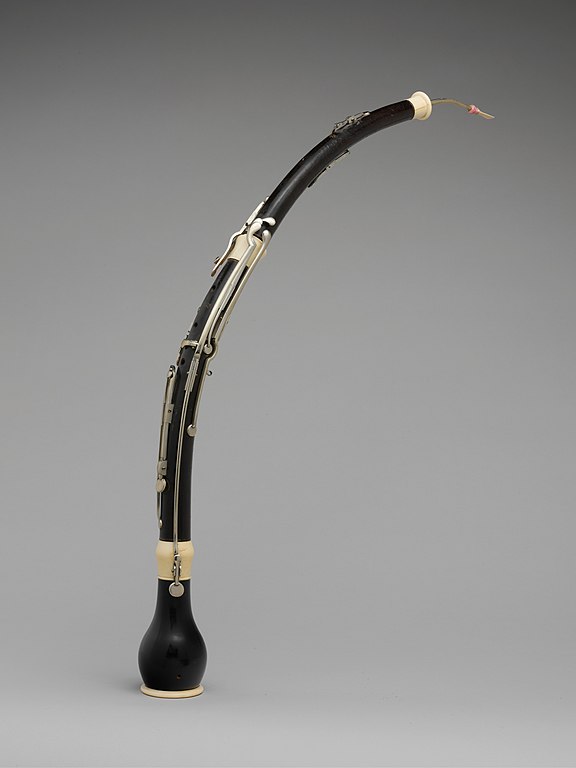 © Wikimedia.org/Carl Theodor Golde, CC0
© Wikimedia.org/Carl Theodor Golde, CC0
The euphonium is a medium-sized, 3 or 4-valve, often compensating, conical-bore, tenor-voiced brass instrument that derives its name from the Ancient Greek word εὔφωνος euphōnos, meaning 'well-sounding' or 'sweet-voiced' (εὖ eu means 'well' or 'good' and φωνή phōnē means 'sound', hence 'of good sound'). The euphonium is a valved instrument. Nearly all current models have piston valves, though some models with rotary valves do exist. Euphonium music may be notated in the bass clef as a non-transposing instrument or in the treble clef as a transposing instrument in B♭. In British brass bands, it is typically treated as a treble-clef instrument, while in American band music, parts may be written in either treble clef or bass clef, or both. A person who plays the euphonium is known as a euphoniumist, a euphonist, a euphophonist or simply a euphonium player.
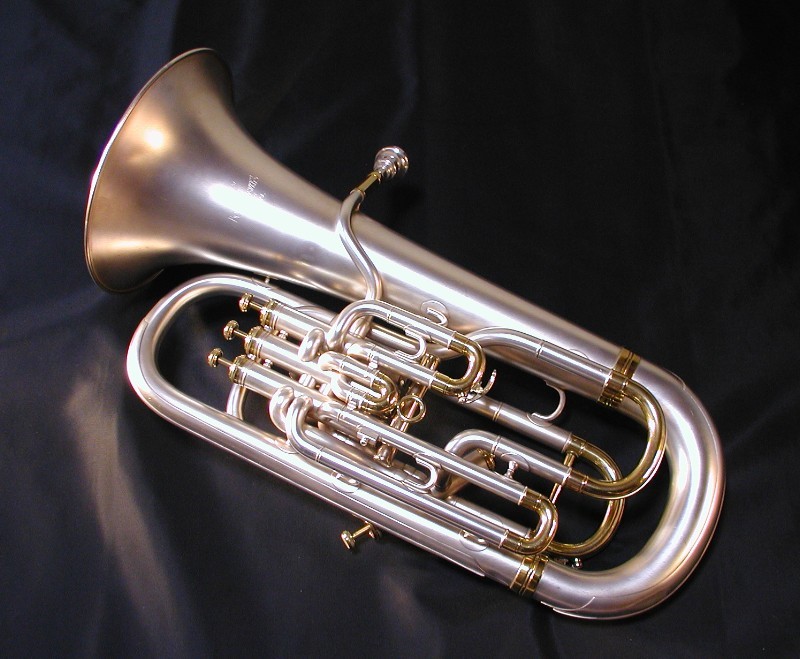 © Wikimedia.org/Hidekazu Okayama, CC BY-SA
© Wikimedia.org/Hidekazu Okayama, CC BY-SA
The ferrinho (in Cape Verdean Creole ferrinhu [feˈʁiɲu]) is a musical instrument, more precisely a scraped idiophone. It is made up by a metal bar (generally of iron) that is scraped by another metal object. The player holds the bar vertically, with its lower end in the palm of one hand and the upper end leaning against the shoulder. With the other hand, the player uses a metallic object, held horizontally, to scrape the bar with up-and-down movements. A custom-made ferrinho is usually 90 centimeters long, with a straight-angle section to ease handling. The ferrinho is used to mark the rhythm in funaná, a musical genre in Cape Verde.
A fife (/faɪf/ FYFE) is a small, high-pitched, transverse aerophone, that is similar to the piccolo. The fife originated in medieval Europe and is often used in fife and drum corps, military units, and marching bands. Someone who plays the fife is called a fifer. The word fife comes from the German Pfeife, meaning pipe, which comes from the Latin word pipare. The fife is a diatonically tuned instrument commonly consisting of a tube with 6 finger holes and an embouchure hole that produces sound when blown across. Modern versions of the fife are chromatic, having 10 or 11 finger holes that allow any note to be played. On a 10-hole fife, the index, middle and ring fingers of both hands remain in the same positions as on the 6-hole fife, while both thumbs and both pinkies are used to play accidentals. An 11-hole fife has holes positioned similarly but adds a second hole under the right middle finger.
The flageolet is a woodwind instrument and a member of the fipple flute family which includes recorders and tin whistles. Its invention was erroneously ascribed to the 16th-century Sieur Juvigny in 1581. There are two basic forms of the instrument: the French, having four finger holes on the front and two thumb holes on the back; and the English, having six finger holes on the front and sometimes a single thumb hole on the back. The latter was developed by English instrument maker William Bainbridge, resulting in the 'improved English flageolet' in 1803. There are also double and triple flageolets, having two or three bodies that allowed for a drone and countermelody. Flageolets were made until the 19th century.
The flexatone or fleximetal is a modern percussion instrument (an indirectly struck idiophone) consisting of a small flexible metal sheet suspended in a wire frame ending in a handle. Used in classic cartoons for its glissando effect, its sound is comparable to the musical saw. The flexatone is sometimes heard in funk music, and occasionally in pop music for special effect. It is occasionally used in the soundtracks of films or cartoons to represent 'ghosts' or other paranormal phenomena.
The flugelhorn (/ˈfluːɡəlhɔːrn/), also spelled fluegelhorn, flugel horn, or flügelhorn, is a brass instrument that resembles the trumpet and cornet but has a wider, more conical bore. Like trumpets and cornets, most flugelhorns are pitched in B♭, though some are in C. It is a type of valved bugle, developed in Germany in the early 19th century from a traditional English valveless bugle. The first version of a valved bugle was sold by Heinrich Stölzel in Berlin in 1828. The valved bugle provided Adolphe Sax (creator of the saxophone) with the inspiration for his B♭ soprano (contralto) saxhorns, on which the modern-day flugelhorn is modeled.
The flute is a member of a family of musical instruments in the woodwind group. Like all woodwinds, flutes are aerophones, producing sound with a vibrating column of air. Unlike woodwind instruments with reeds, a flute produces sound when the player's air flows across an opening. In the Hornbostel–Sachs classification system, flutes are edge-blown aerophones. A musician who plays the flute is called a flautist or flutist. Paleolithic flutes with hand-bored holes are the earliest known identifiable musical instruments. A number of flutes dating to about 53,000 to 45,000 years ago have been found in the Swabian Jura region of present-day Germany, indicating a developed musical tradition from the earliest period of modern human presence in Europe. While the oldest flutes currently known were found in Europe, Asia also has a long history with the instrument. A playable bone flute discovered in China is dated to approximately 9000 years ago. The Americas also had an ancient flute culture, with instruments found in Caral, Peru, dating back 5000 years and in Labrador dating back approximately 7500 years.
The Flutina is an early precursor to the diatonic button accordion, having one or two rows of treble buttons, which are configured to have the tonic of the scale, on the 'draw' of the bellows. There is usually no bass keyboard: the left hand operates an air valve (silent except for the rush of air). A rocker switch, called a 'bascule d'harmonie' is in the front of the keyboard. When this switch is thumb activated, it would open up a pallet (a pad that covers a tone hole, at the other end of the key button(s), (see photo) for a simple Tonic/Dominant drone: Tonic on the draw and Dominant on the press, e.g. Tonic notes C/g, and Dominant G/d, without any major or minor thirds.
 © Wikimedia.org, CC0
© Wikimedia.org, CC0
The French horn (since the 1930s known simply as the horn in professional music circles) is a brass instrument made of tubing wrapped into a coil with a flared bell. The double horn in F/B♭ (technically a variety of German horn) is the horn most often used by players in professional orchestras and bands, although the descant and triple horn have become increasingly popular. A musician who plays a horn is known as a horn player or hornist.
The fujara (Slovak pronunciation: [ˈfujara]) is a large wind instrument of the tabor pipe class. It originated in central Slovakia as a sophisticated folk shepherd's overtone fipple flute of unique design in the contrabass range.Ranging from 160 to 200 cm long and tuned in A, G, or F. It has three tone holes (also called finger holes) located on the lower part of the main body. The sound is produced by a fipple at the upper end of the main body of the fujara. The air is led to the fipple through a smaller parallel pipe, called vzduchovod in Slovak (meaning 'air channel'), mounted on the main body of the instrument. While it is possible to play the fundamental frequency on fujaras, the normal playing technique is based on overblowing the instrument. Because of the high aspect ratio of the sound chamber (great length versus small internal diameter), the player can use overtones to play a diatonic scale using only the three tone holes. The fujara is typically played while standing, with the instrument held vertically and usually braced against the right thigh.
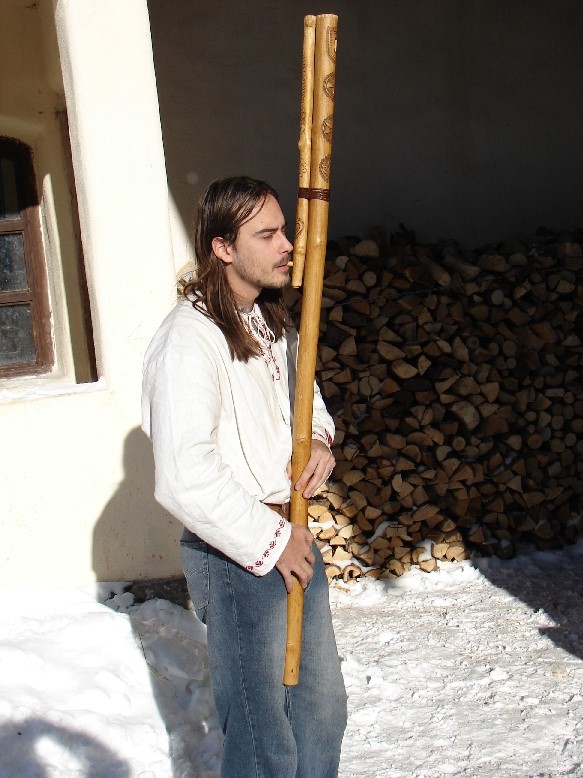 © Wikimedia.org/Igor Chyra, CC BY-SA
© Wikimedia.org/Igor Chyra, CC BY-SA
Bagpipes are a woodwind instrument using enclosed reeds fed from a constant reservoir of air in the form of a bag. The Great Highland bagpipes are well known, but people have played bagpipes for centuries throughout large parts of Europe, Northern Africa, Western Asia, around the Persian Gulf and northern parts of South Asia.
 © Wikimedia.org/Maniatis1, CC BY-SA
© Wikimedia.org/Maniatis1, CC BY-SA
The gandingan is a Philippine set of four large, hanging gongs used by the Maguindanao as part of their kulintang ensemble. When integrated into the ensemble, it functions as a secondary melodic instrument after the main melodic instrument, the kulintang. When played solo, the gandingan allows fellow Maguindanao to communicate with each other, allowing them to send messages or warnings via long distances. This ability to imitate tones of the Maguindanao language using this instrument has given the gandingan connotation: the “talking gongs.”
The gemshorn is an instrument of the ocarina family that was historically made from the horn of a chamois, goat, or other suitable animal. The gemshorn receives its name from the German language, in which Gemshorn means a 'chamois horn'. Modern gemshorns are often made of the horns of domesticated cattle, because they are readily available, and their use prevents endangering wild species. The hollow horn has tone holes down the front, like a recorder or clarinet. The pointed end of the horn is left intact, and serves as the bottom of the instrument. A fipple plug, usually of wood, is fitted into the wide end of the instrument, with a recorder type voicing window on the front of the horn, for tone production.
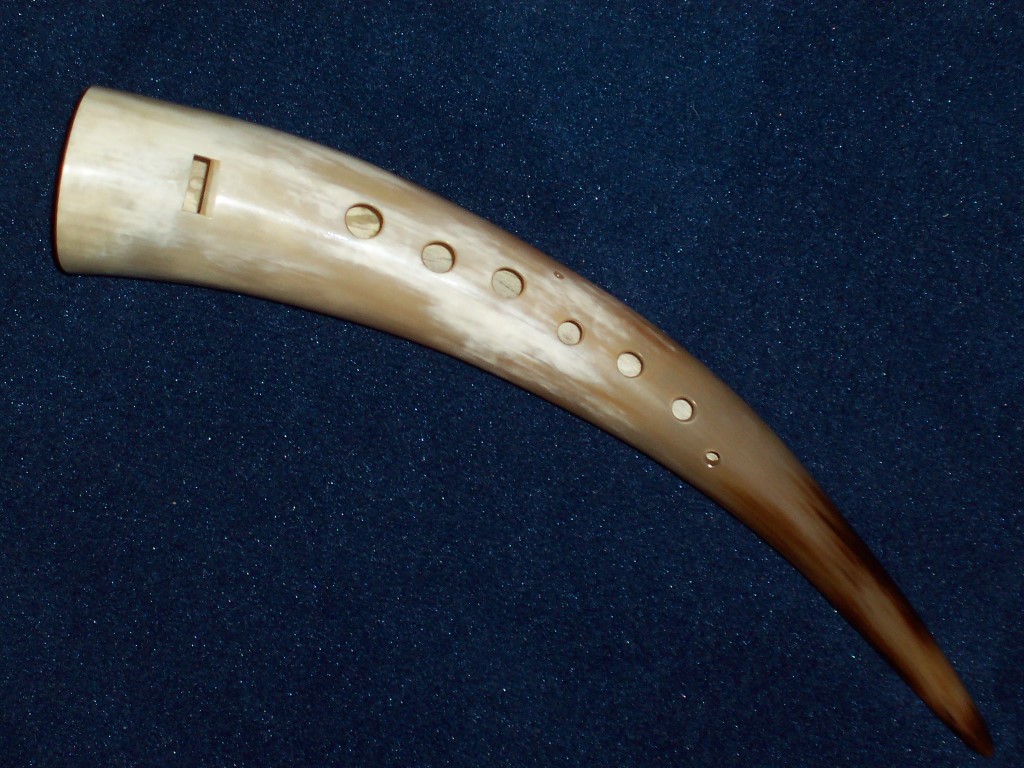 © Wikimedia.org/RiderOfRohan1981, CC BY-SA
© Wikimedia.org/RiderOfRohan1981, CC BY-SA
The ghaṭam (Sanskrit: घटं ghaṭaṁ, Kannada: ಘಟ ghaṭah, Tamil: கடம் ghatam, Telugu: ఘటం ghatam, Malayalam: ഘടം, ghatam) is a percussion instrument used in various repertoires across India especially in Tamil Nadu. It's a variant played in Punjab and known as gharha as it is a part of Punjabi folk traditions. Its analogue in Rajasthan is known as the madga and pani mataqa ('water jug'). The ghatam is one of the most ancient percussion instruments of India. It is a clay pot with narrow mouth. From the mouth, it slants outwards to form a ridge. Made mainly of clay baked with brass or copper filings with a small amount of iron filings, the pitch of the ghatam varies according to its size. The pitch can be slightly altered by the application of plasticine clay or water.[page needed]
The glockenspiel (/ˈɡlɒkənʃpiːl/ GLO-kən-shpeel; German pronunciation: [ˈɡlɔkənˌʃpiːl] or [ˈɡlɔkŋ̍ˌʃpiːl], Glocken: bells and Spiel: play) or bells is a percussion instrument consisting of pitched aluminum or steel bars arranged in a keyboard layout. This makes the glockenspiel a type of metallophone, similar to the vibraphone. The glockenspiel is played by striking the bars with mallets, often made of a hard material such as metal or plastic. Its clear, high-pitched tone is often heard in orchestras, wind ensembles, marching bands, and in popular music.
The goblet drum (also chalice drum, tarabuka, tarabaki, darbuka, darabuka, derbake, debuka, doumbek, dumbec, dumbeg, dumbelek, toumperleki, tumbak, or zerbaghali; Egyptian Arabic: دربوكة / Romanized: darbuka) is a single-head membranophone with a goblet-shaped body. It is most commonly used in the traditional music of Egypt, where it is considered the national symbol of Egyptian Shaabi Music. The instrument is also featured in traditional music from West Asia, North Africa, South Asia, and Eastern Europe. The African djembe is also a goblet membranophone. This article focuses on the Middle Eastern and North African goblet drum.
A gong is a percussion instrument originating in East Asia and Southeast Asia. Gongs are a flat, circular metal disc that is typically struck with a mallet. They can be small or large in size, and tuned or can require tuning. The earliest mention of gongs can be found in sixth century Chinese records, which mentioned the instrument to have come from a country between Tibet and Burma. The term gong (Javanese: ꦒꦺꦴꦁ) originated in the Indonesian island of Java. Scientific and archaeological research has established that Burma, China, Java and Annam were the four main gong manufacturing centres of the ancient world. The gong found its way into the Western World in the 18th century, when it was also used in the percussion section of a Western-style symphony orchestra.[citation needed] A form of bronze cauldron gong known as a resting bell was widely used in ancient Greece and Rome: for instance in the famous Oracle of Dodona, where disc gongs were also used.
 © Wikimedia.org/Julia Kostrova, CC BY-SA
© Wikimedia.org/Julia Kostrova, CC BY-SA
A gong bass drum (or simply gong drum) is a musical instrument in the percussion family. It is a type of drum that uses a single large drumhead in order to create a loud, resonant sound when struck. The head can be tuned as loose as possible to avoid any sense of pitch in the sound, or tensioned more tightly to produce timpani-like tones. Gong bass drums are usually relatively large, and are most frequently found in 20' and custom ordered 22' diameters. Orchestral versions can be 28' standard, but there are special larger ones (see below). They are often mounted on legs (much like that of a floor tom), 'rollaway' stands or ordinary tom stands/arms (though usually a pair are used for stability).
The guitar is a fretted musical instrument that typically has six strings. It is usually held flat against the player's body and played by strumming or plucking the strings with the dominant hand, while simultaneously pressing selected strings against frets with the fingers of the opposite hand. A plectrum or individual finger picks may also be used to strike the strings. The sound of the guitar is projected either acoustically, by means of a resonant chamber on the instrument, or amplified by an electronic pickup and an amplifier. The guitar is classified as a chordophone – meaning the sound is produced by a vibrating string stretched between two fixed points. Historically, a guitar was constructed from wood with its strings made of catgut. Steel guitar strings were introduced near the end of the nineteenth century in the United States; nylon strings came in the 1940s. The guitar's ancestors include the gittern, the vihuela, the four-course Renaissance guitar, and the five-course baroque guitar, all of which contributed to the development of the modern six-string instrument.
 © Wikimedia.org/Mestremendo, CC BY-SA
© Wikimedia.org/Mestremendo, CC BY-SA
The güiro (Spanish pronunciation: [ˈɡwiɾo]) is a percussion instrument consisting of an open-ended, hollow gourd with parallel notches cut in one side. It is played by rubbing a stick or tines (see photo) along the notches to produce a ratchet sound. The güiro is commonly used in Cuban, Puerto Rican, and other forms of Latin American music, and plays a key role in the typical rhythm section of important genres like son, trova and salsa. Playing the güiro usually requires both long and short sounds, made by scraping up and down in long or short strokes.
Handpan is a term for a group of musical instruments that are classified as a subset of the steelpan. Several handpan makers and brands have emerged in recent years, resulting from a growing worldwide interest in the Hang, which is an instrument developed by the company PANArt that is based on the physical properties of the Trinidadian steelpan, Indian ghatam, Thai gong and Indonesian Gamelan etc. The basic form of a handpan consists of two metal half-shells glued together, a centre tone field (named Ding) surrounded by a circle of at least seven tone fields on the upper side and an opening in the bottom side (named Gu). Differences between manufacturers include the used materials, the manufacturing processes of the raw forms, the shaping of the tone fields and the tuning methods.
The Hang (German pronunciation: [haŋ]; plural form: Hanghang) is a type of musical instrument called a handpan, fitting into the idiophone class and based on the Caribbean steelpan instrument. It was created by Felix Rohner and Sabina Schärer in Bern, Switzerland. The name of their company is PANArt Hangbau AG. The Hang is sometimes referred to as a hang drum, but the inventors consider this a misnomer and strongly discourage its use. The instrument is constructed from two half-shells of deep drawn, nitrided steel sheet glued together at the rim leaving the inside hollow and creating the shape of a convex lens. The top ('Ding') side has a center 'note' hammered into it and seven or eight 'tone fields' hammered around the center. The bottom ('Gu') is a plain surface that has a rolled hole in the center with a tuned note that can be created when the rim is struck.
The harmonica, also known as a French harp or mouth organ, is a free reed wind instrument used worldwide in many musical genres, notably in blues, American folk music, classical music, jazz, country, and rock. The many types of harmonica include diatonic, chromatic, tremolo, octave, orchestral, and bass versions. A harmonica is played by using the mouth (lips and tongue) to direct air into or out of one (or more) holes along a mouthpiece. Behind each hole is a chamber containing at least one reed. The most common is the diatonic Richter-tuned with ten air passages and twenty reeds, often called the blues harp. A harmonica reed is a flat, elongated spring typically made of brass, stainless steel, or bronze, which is secured at one end over a slot that serves as an airway. When the free end is made to vibrate by the player's air, it alternately blocks and unblocks the airway to produce sound.
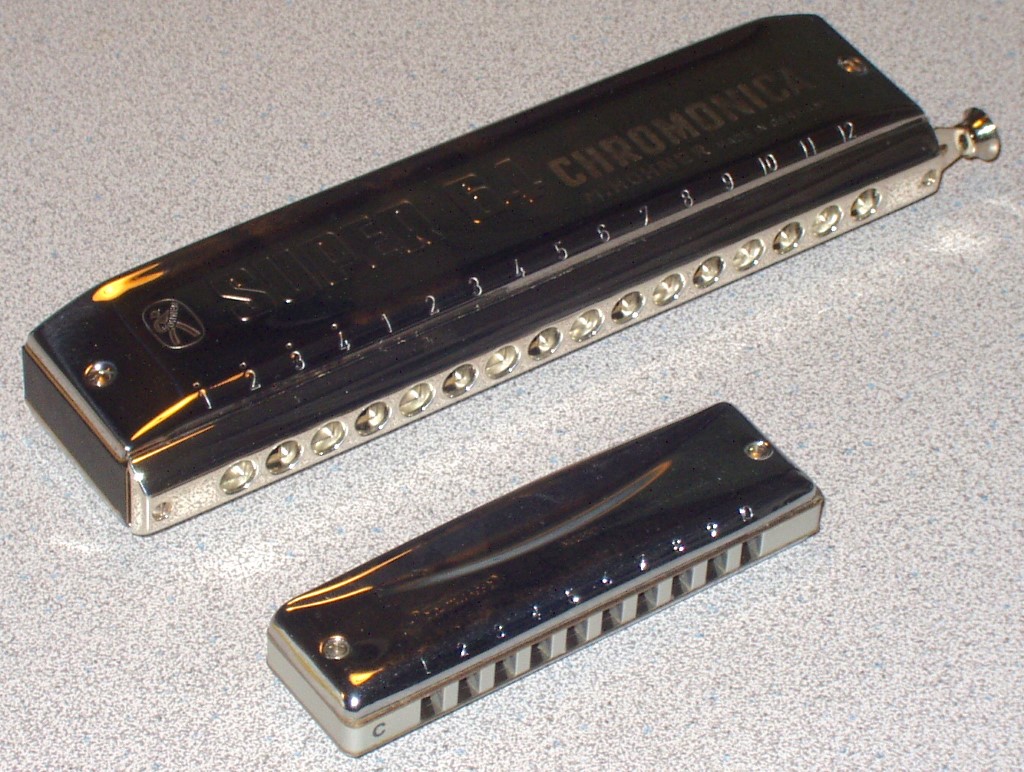 © Wikimedia.org/ George Leung, CC BY-SA
© Wikimedia.org/ George Leung, CC BY-SA
The harp is a stringed musical instrument that has individual strings running at an angle to its soundboard; the strings are plucked with the fingers. Harps can be made and played in various ways, standing or sitting, and in orchestras or concerts. Its most common form is triangular in shape and made of wood. Some have multiple rows of strings and pedal attachments. Ancient depictions of harps were recorded in Mesopotamia, Persia (now Iraq and Iran) and Egypt, and later in India and China. By medieval times harps had spread across Europe. Harps were found across the Americas where it was a popular folk tradition in some areas. Distinct designs also emerged from the African continent. Harps have symbolic political traditions and are often used in logos, including in Ireland.
The harp guitar is a guitar-based stringed instrument generally defined as a 'guitar, in any of its accepted forms, with any number of additional unstopped strings that can accommodate individual plucking.' The word 'harp' is used in reference to its harp-like unstopped open strings. A harp guitar must have at least one unfretted string lying off the main fretboard, typically played as an open string. This family consists of many varieties of instrument configurations. Most readily identified are American harp guitars with either hollow arms, double necks or harp-like frames for supporting extra bass strings, and European bass guitars (or contraguitars). Other harp guitars feature treble or mid-range floating strings, or various combinations of multiple floating string banks along with a standard guitar neck.
The hulusi (traditional: 葫蘆絲; simplified: 葫芦丝; pinyin: húlúsī), also known as the cucurbit flute and the gourd flute is a free reed wind instrument from China, Vietnam and the Shan State and by the indigenous people of Assam. It is held vertically and has three bamboo pipes that pass through a Calabash gourd wind chest; the center pipe has finger holes and the outer two are typically drone pipes. It is not uncommon for a hulusi to have only one drone pipe while the second outer pipe is merely ornamental. The drone pipe has a finger hole which allows it to be stopped. Advanced configurations have keyed finger holes similar to a clarinet or oboe, which can greatly extend the range of the hulusi to several octaves.
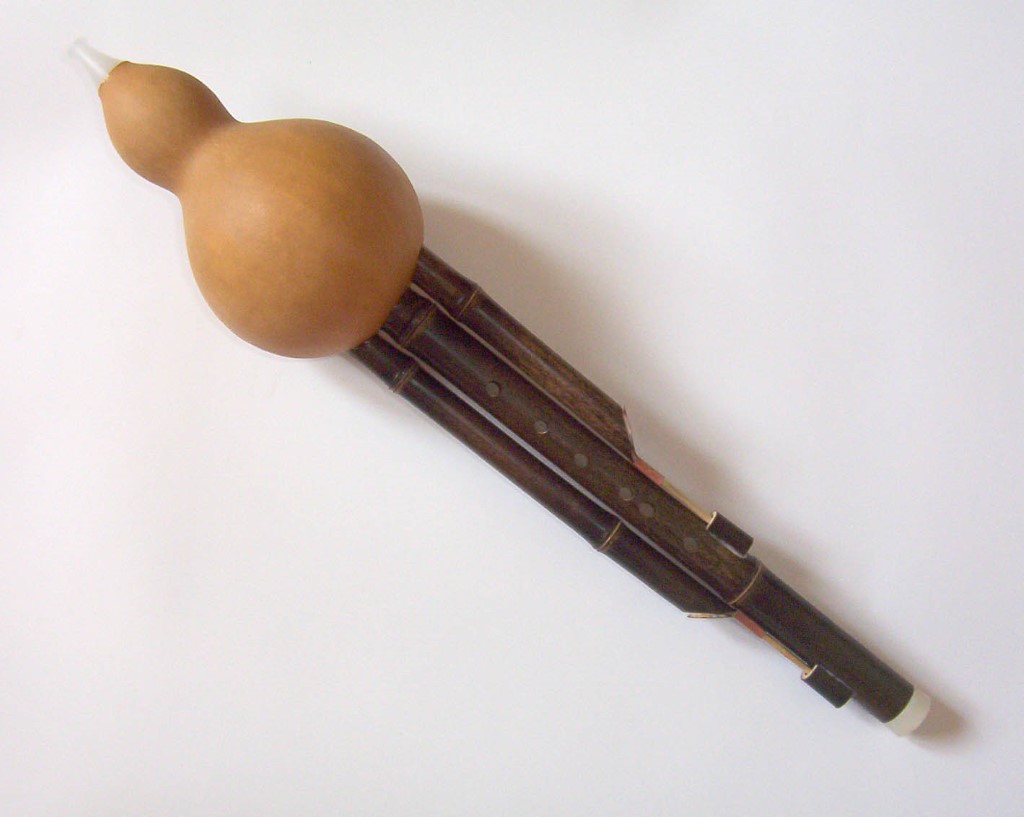 © Wikimedia.org/F.Schmidtke, CC0
© Wikimedia.org/F.Schmidtke, CC0

Time for recess! Post a comment, ask a question or write a review. Feel free to let us know what you think!
look at the sign on the road to avoid accidents and horrible driving conditions
I received a 300$ ticket because I passed a police control of other cars/drivers on the right lane of a highway (the control was on the hard shoulder of the highway). Is it really true, that you have to change the lane in such cases? Thanks!
I am an American living in Italy. The Italian Drivers License theory test is the hardest test I have ever studied for and I am in my 70s have multiple degrees, multiple professional certifications. Have to take the Italian Drivers Theory test in Italian. No english. So many rules. More signs in small medieval Italian town I live in then in major US cities I have lived in. No Italian license no driving. No buying or renting a car. Test here was good, clean. Lots of tricky questions on many practice and real official tests. Thanks
Most problems are a result of higher than safe driving speeds. Please just slow down and be patient.
Question 121: Poor translation: Vehicles with polluted fluids prohibited Should be translated as: Vehicles with dangerous liquids prohibited
Question 83: Poor translation: Vehicles with polluted fluids prohibited Should be translated as: Vehicles with dangerous liquids prohibited
Want even more practice? Visit similar websites offering realistic practice driving knowledge tests. Visit us to see what sets our tests apart! https://dkttest.com/capital-territory/
Cool tool! And fun to check whether I remember the rules :) Two things I noticed: Warning for a crossroad side roads on the left and right. While technically that might be the correct translation, this sign tells you, that you are on the main road and have the right of way for the next crossroad and only the next crossroad. Usually (if no sign specifies otherwise) you have to give way to drivers coming from the right at every intersection, which can get a bit annoying in communal areas, so seeing this sign feels less like a warning and more like relief :). A Fahrradstraße is not a lane for cyclists but a street for cyclists, meaning the (whole!) street is intended predominantly for cyclists, who are then allowed to ride next to each other. Cars are allowed to drive there (unless another sign prohibits such), but have to adjust their speed to the cyclists. I believe they are not allowed to pass at all, even if the oncoming lane is empty.
More community